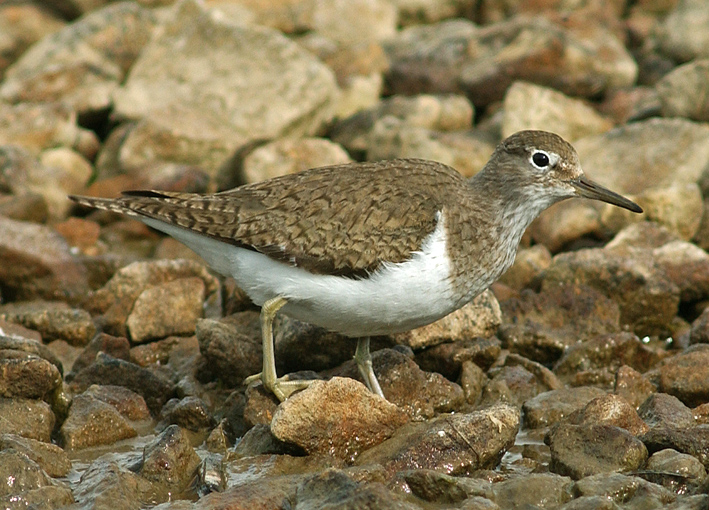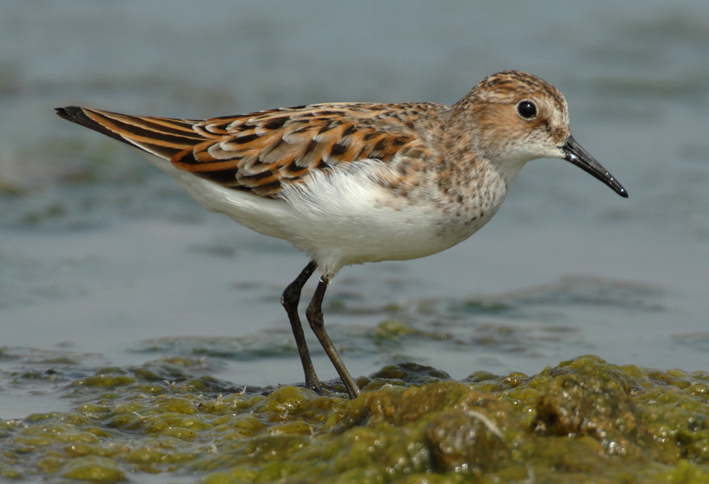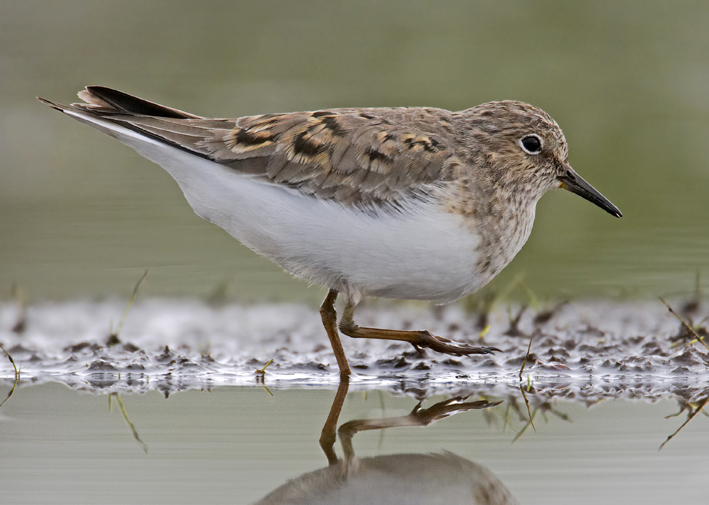Among the most confusing of our wader species are the smaller ones, now appearing in their bright summer plumage after months in dowdy winter fatigues.
One of the biggest moult transformations is in Sanderling, which by May has emerged from its largely white winter plumage as a rufous-tinged beauty. A close look will reveal the absence of a hind-toe on its graphite-black legs, but it also has a comparatively thick and straight black bill. It is roughly the size of a plump Dunlin and typically runs around in small groups on the sandier coastal substrates.
In full spring garb, Sanderling has a black-streaked rufous face, and the reddish colour continues onto the breast, finishing abruptly at a pectoral band above pure white underparts. The black-centred white-fringed feathers of the mantle and scapulars look ‘scaly’. Birds can still be moulting in late spring and may retain some of their grey winter livery on the mantle.
In flight, Sanderling has a broad, long white wing-bar, obviously bordered with black and reminiscent of Turnstone. The underwing is also notably pale, with no sign of a dark bar. Sanderling is quiet, but the flight call is a squeaky, high-pitched plit plit plit.
A summer Sanderling can cause confusion with summer-plumaged Little Stint. This is due to its rufous breast and its habit of running manically around at the edge of vegetation on its favoured mudflats. However, Little Stint is smaller than Sanderling and its rufous tinge spreads onto the mantle, scapulars and flight feathers. The plain rufous colour extends onto the crown-sides as a ‘split’ supercilium. The mantle looks streakier and smaller-feathered than Sanderling, and is bordered by pale yellow stripes.
The blackish bill is finer and spiky-looking and the legs are also black, while the primaries are at least as long as the shortish tail. In flight there is a thin white wing-bar, and grey sides to the black-centred tail. Listen out for a flight call similar to Sanderling, but with a more ‘whistled’ overtone.
Sanderling and Little Stint are mostly coastal species, but can share inland sites with Temminck’s Stint. Even in summer, Temminck’s is a duller species than the other two, but bright individuals can be washed with a rufous tone on the front end. The supercilium is vaguer and ‘unsplit’, and there is a strong eyering. The primaries – or the tertials that can cover them – are usually shorter than the longish tail, giving a more attenuated shape than Little. The breast and head are brownish-grey, again finishing with a diffuse pectoral band. There are no prominent stripes on the mantle. The legs vary in colour from grey-green to yellow, but are never black unless covered in mud.
In flight, Temminck’s resembles Little but has white tail sides, and utters a fast and abrupt trrrrrr.
Common Sandpiper is a true freshwater specialist, but even this species turns up on brackish river estuaries. The main pitfall here is Temminck’s Stint – the duller summer birds can be disarmingly similar at a distance. However, Common Sandpiper’s distinctive bobbing ‘jizz’ helps differentiate it from the slow-moving and creeping stint.
Like Temminck’s, Common Sandpiper also has a slight rufous tinge to its familiar plumage in summer and a relatively long tail. However, the white gap extending from the white underparts between the ‘shoulder’ and the very clear-cut pectoral line are distinctive. Common Sandpiper’s upperparts are more uniform, with fine black arrowheads on the mantle feathers and finely barred tertials and tail.
Its flight style is unmistakeable, rocking from side to side with shallow ‘flicking’ wingbeats, and it has an almost Meadow Pipit-like flight call: swee-swee-swee-swee.
.jpg) |
 |
| Sanderling (Varanger, Norway, 18 June 2006). A gem of a bird in spring, the rufous marbling of this species in breeding plumage can lead to confusion with Little Stint (below). Photo by Jari Peltomäki (www.agami.nl). | Common Sandpiper (Marshside Marsh, Lancashire, 6 June 2004). This species can be confused with Temminck’s Stint (below) at a distance, but its front-heavy jizz, constant bobbing action and white ‘shoulder wedge’ should aid identification. Photo by Steve Young (www.birdsonfilm.com). |
 |
 |
| Little Stint (Lesvos, Greece, 6 May 2007). Smaller, more slender and less blotchy than Sanderling (above), a spring Little Stint is a subtler, more delicate bird. Note the different upperparts patterning. Photo by Richard Brooks (www.richard-brooks.co.uk). | Temminck’s Stint (Loviisa, Finland, 26 May 2007). The greyer and less varied upperparts, along with the long tail and paler legs, can all be clearly seen here. Photo by Markus Varesvuo (www.birdphoto.fi). |


